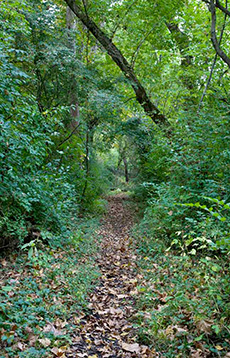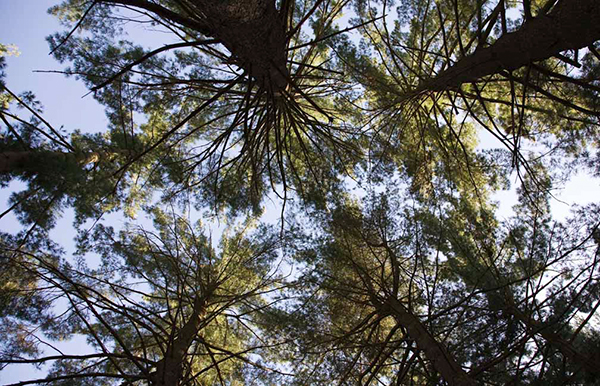Woodlands

Woodlands are ecosystems with 50–80% canopy cover of trees. These extensive light gaps are maintained by low-intensity fire which results in two main vegetation layers—the canopy of large trees with fire resistant bark, and the ground cover of perennial herbaceous plants whose roots survive fires and can resprout. Some woodlands may also contain a shrub layer but, like savannahs, are missing a developed understory layer of small trees present in closed-canopy forests.
In Missouri, common canopy species of woodlands include swamp white oak, big shellbark hickory, shagbark hickory, bur oak, pecan, bitternut hickory, northern red oak, white oak, elm, walnut, cottonwood, and black cherry. Groundcover species include spiderwort, sedges, beak grass, Virginia wild rye, white anemone, bluebells, wood reed grass, wild senna, tall bellflower, wood nettle, green briar, and poison ivy. Fauna include raccoon, beaver, muskrat, great blue heron, barred owl, red-shouldered hawk, pileated woodpecker, red-headed woodpecker, whip-poor-will, Baltimore oriole, Cooper’s hawk, eastern garter snake, black rat snake, southern leopard frog, and five-lined skink.
Open woodland and savannah systems with few trees and a rich groundcover of herbaceous once dominated most of Missouri prior to the suppression of fire brought by European settlers. Much of the Ozarks were savannah and woodland, and all of pre-settlement Missouri was potential habitat for one or more savannah or woodland communities. Now, most of these more open systems have been invaded by shrubs, small trees, and many of the herbaceous species once present are gone, shaded out by these fire-intolerant competitors.
At the Litzsinger Road Ecology Center, we are restoring a rich wet-mesic bottomland woodland system by reintroducing fire and controlling invasive species (see Woodland Restoration for more details). The restored system has openings in the canopy to encourage a rich herbaceous layer of vegetation as well as dominant tree species.
References
Ladd, D. 1991. “Reexamination of the Role of Fire in Missouri Oak Woodlands.” Proceedings of the Oak Woods Management Workshop. Eastern Illinois University: Charleston, IL. pp. 67-80.
Nelson, P. W. 1985. The Terrestrial Natural Communities of Missouri. The Missouri Natural Areas Committee: Jefferson City, MO.
Nuzzo, V. A. 1994. “Extent and status of Midwest oak savanna: Presettlement and 1985.” Proceedings of the North American Conference on Savannas and Barrens: Living in the Edge. Illinois State University: Normal, IL. pp. 1-23.
Packard, S. and C. F. Mutel. 1997. The Tallgrass Restoration Handbook. Island Press: Washington, DC.
Links (links below will open in a new window):
- Missouri Department of Conservation
http://mdc.mo.gov - Nature Conservancy, Missouri Chapter
http://nature.org/wherewework/northamerica/states/missouri/ - Shaw Nature Reserve
http://www.shawnature.org/ - What’s It Like Where You Live?—Temperate Deciduous Forest
http://mbgnet.mobot.org/sets/temp/
